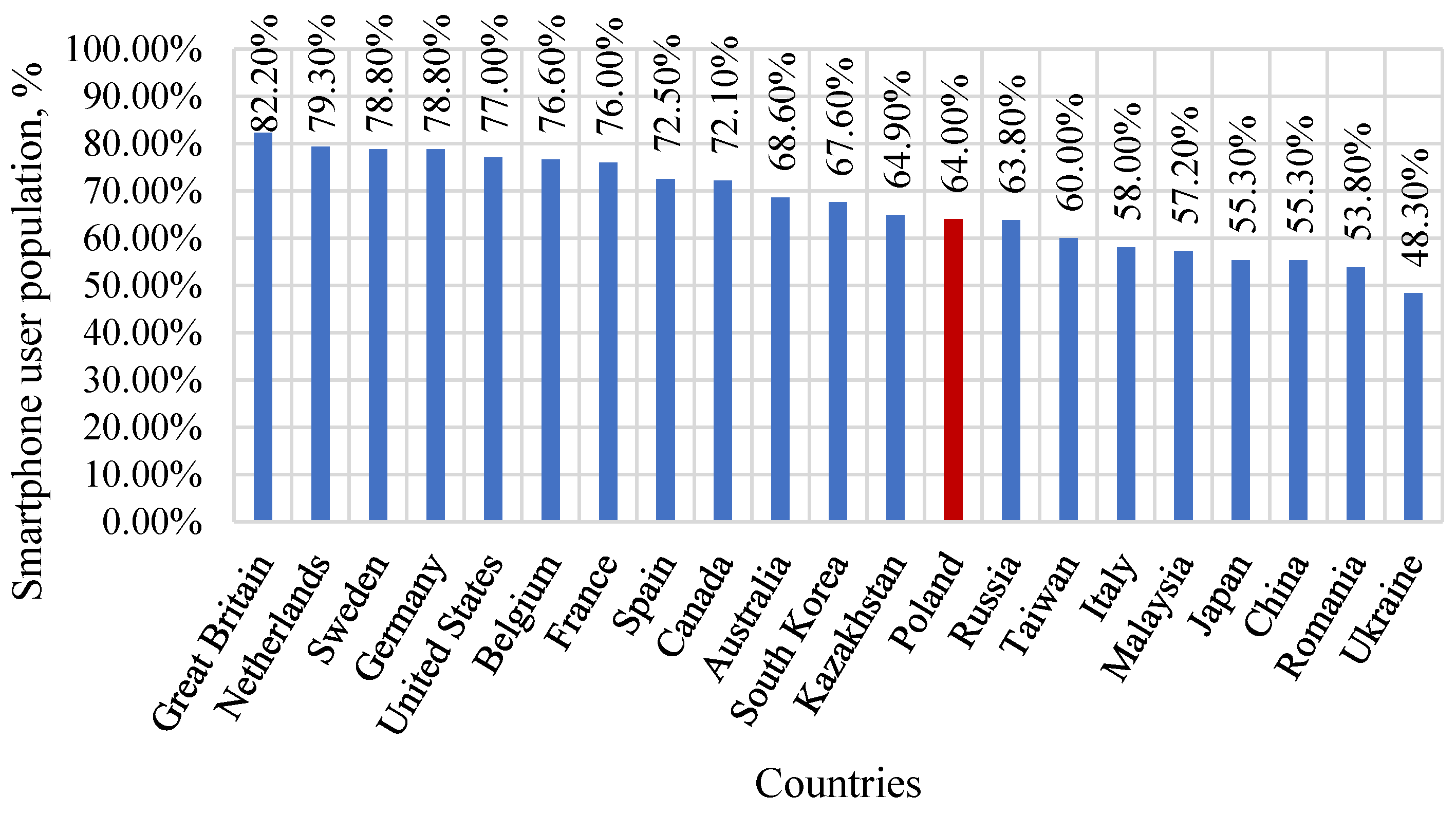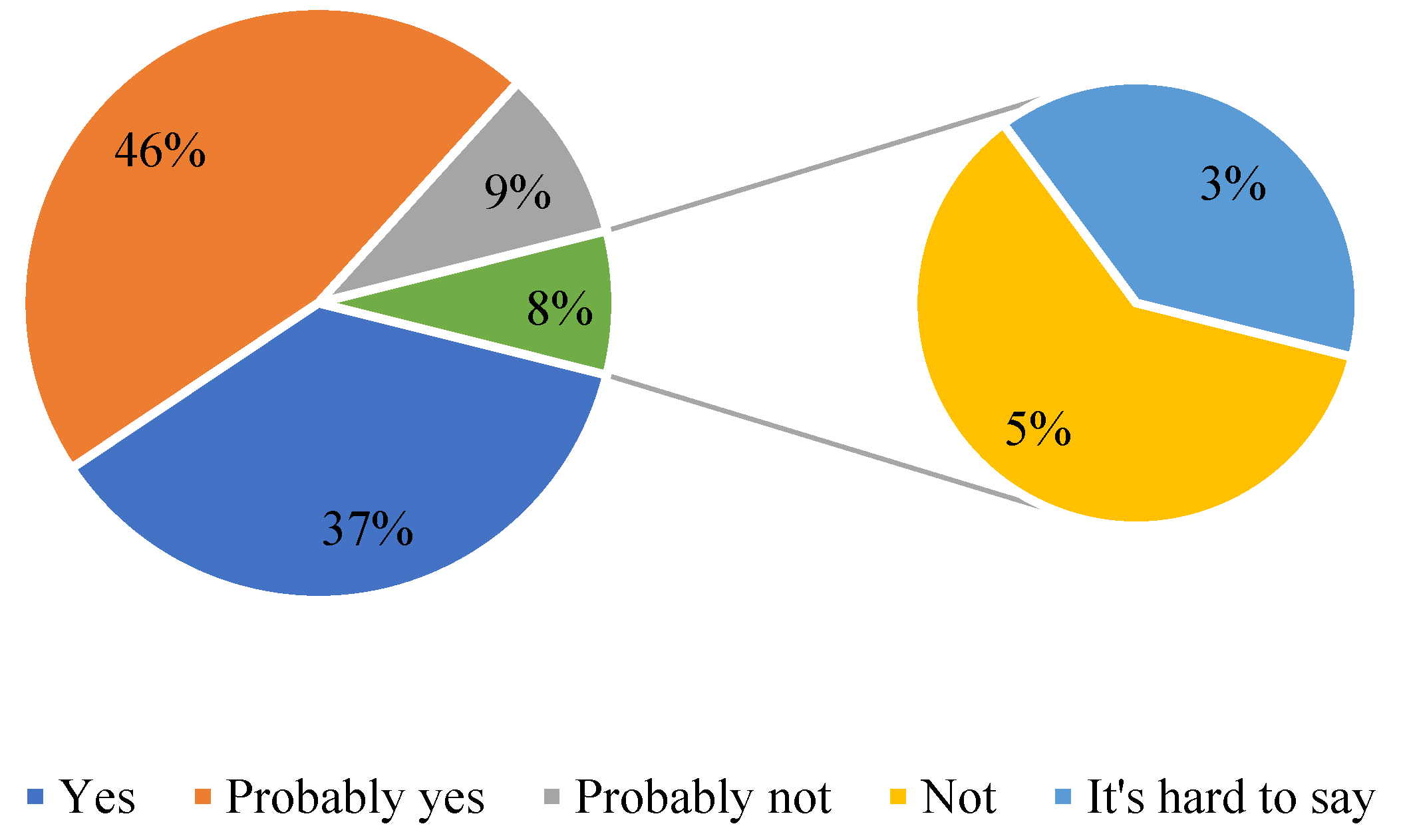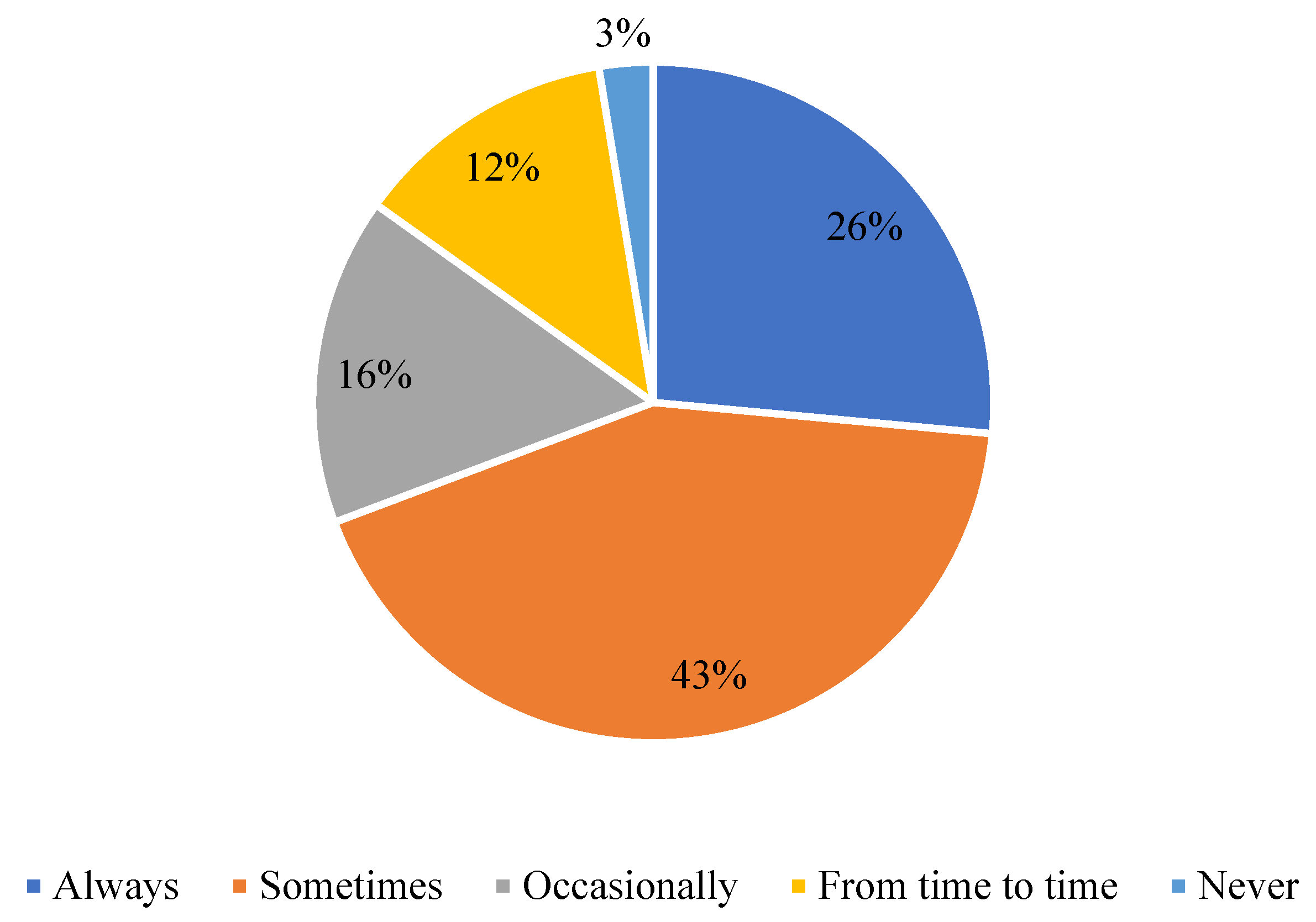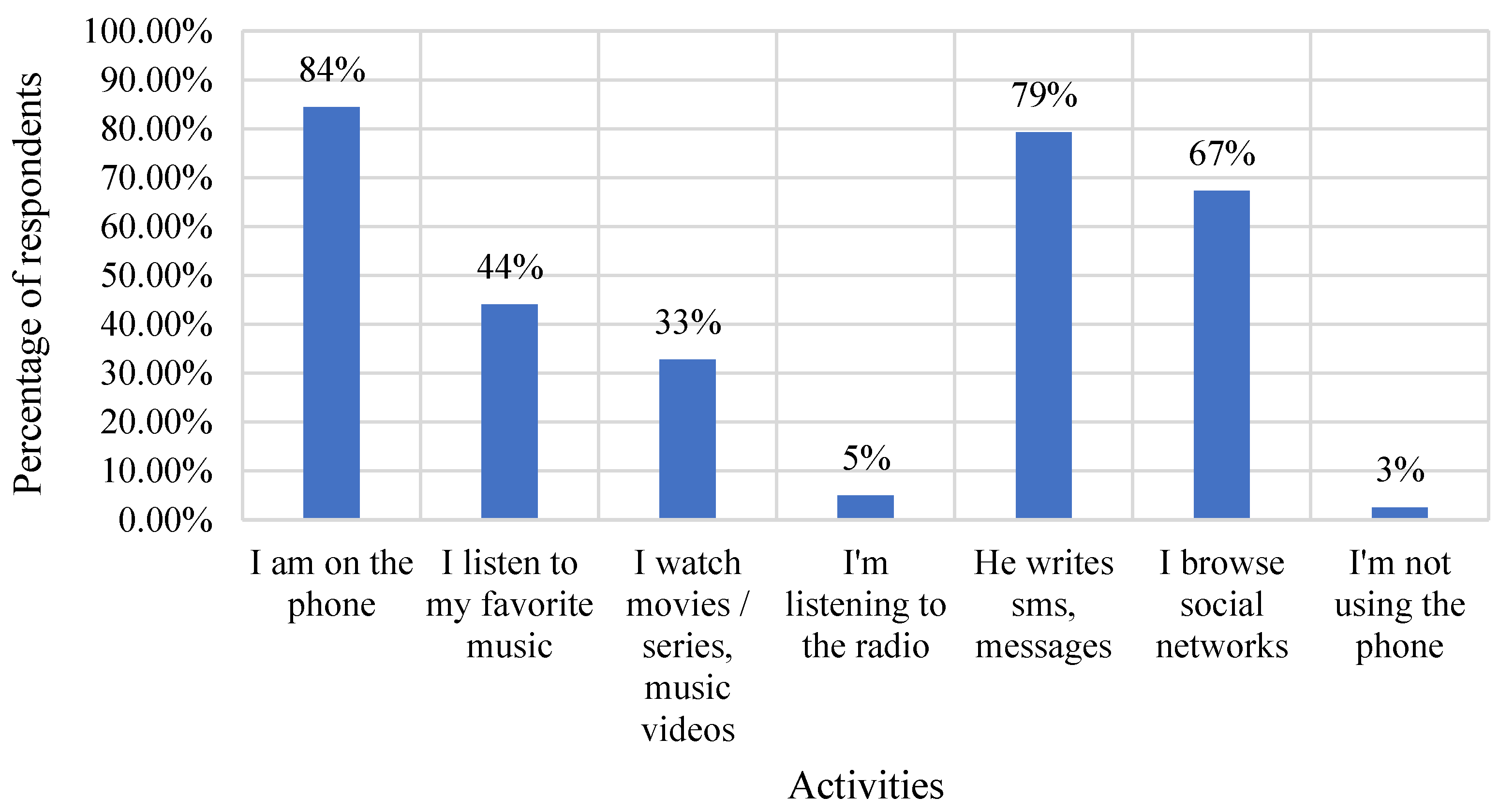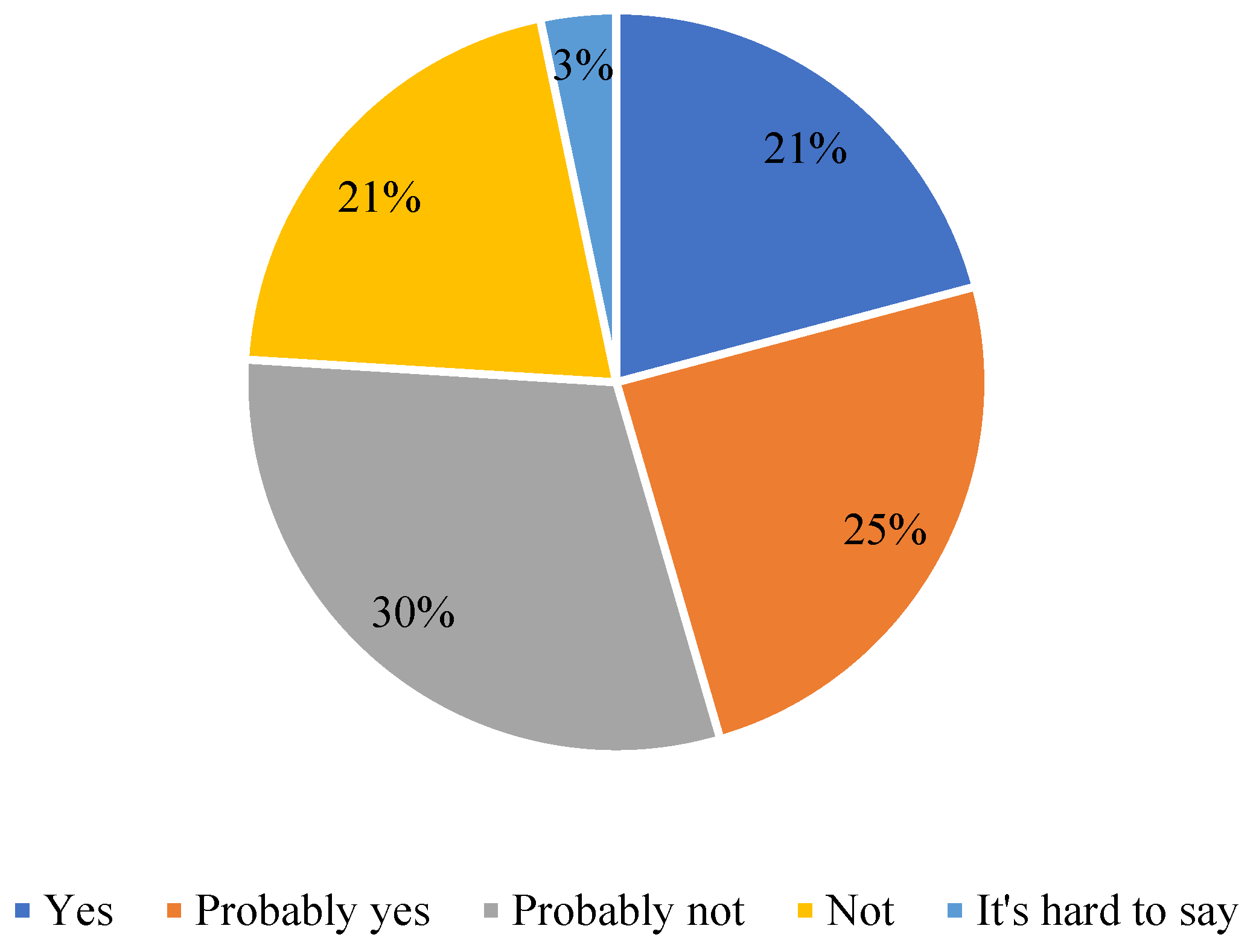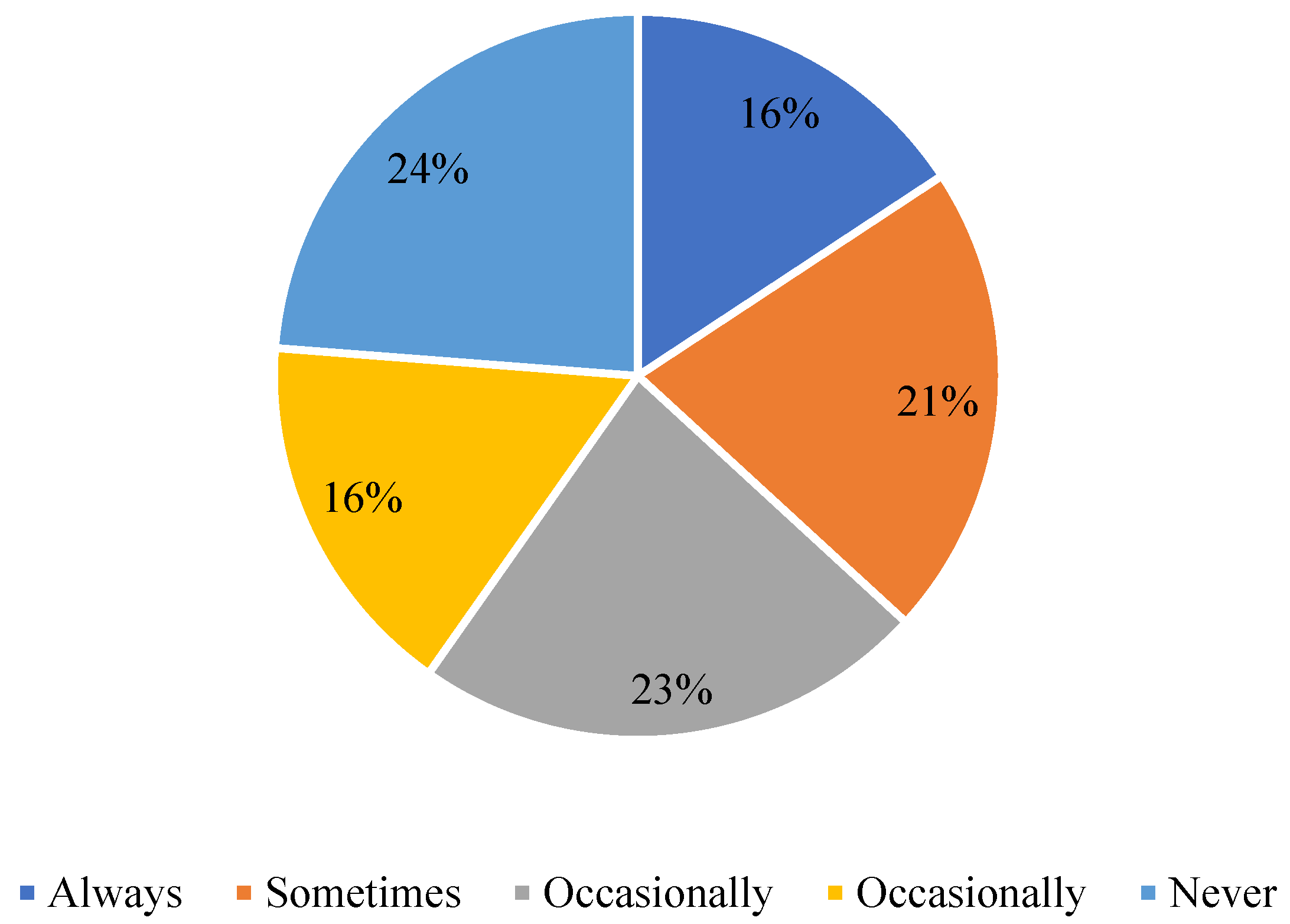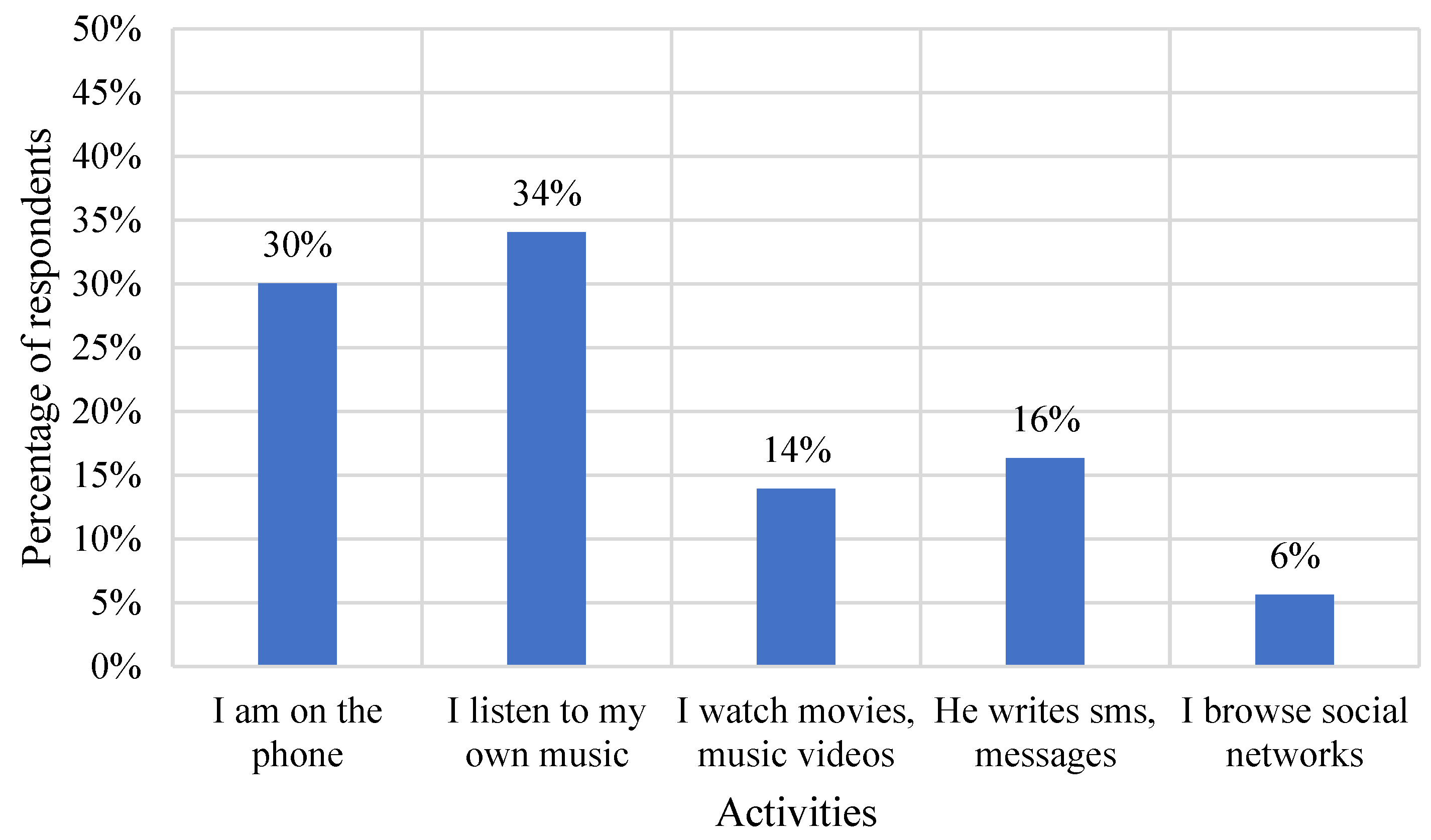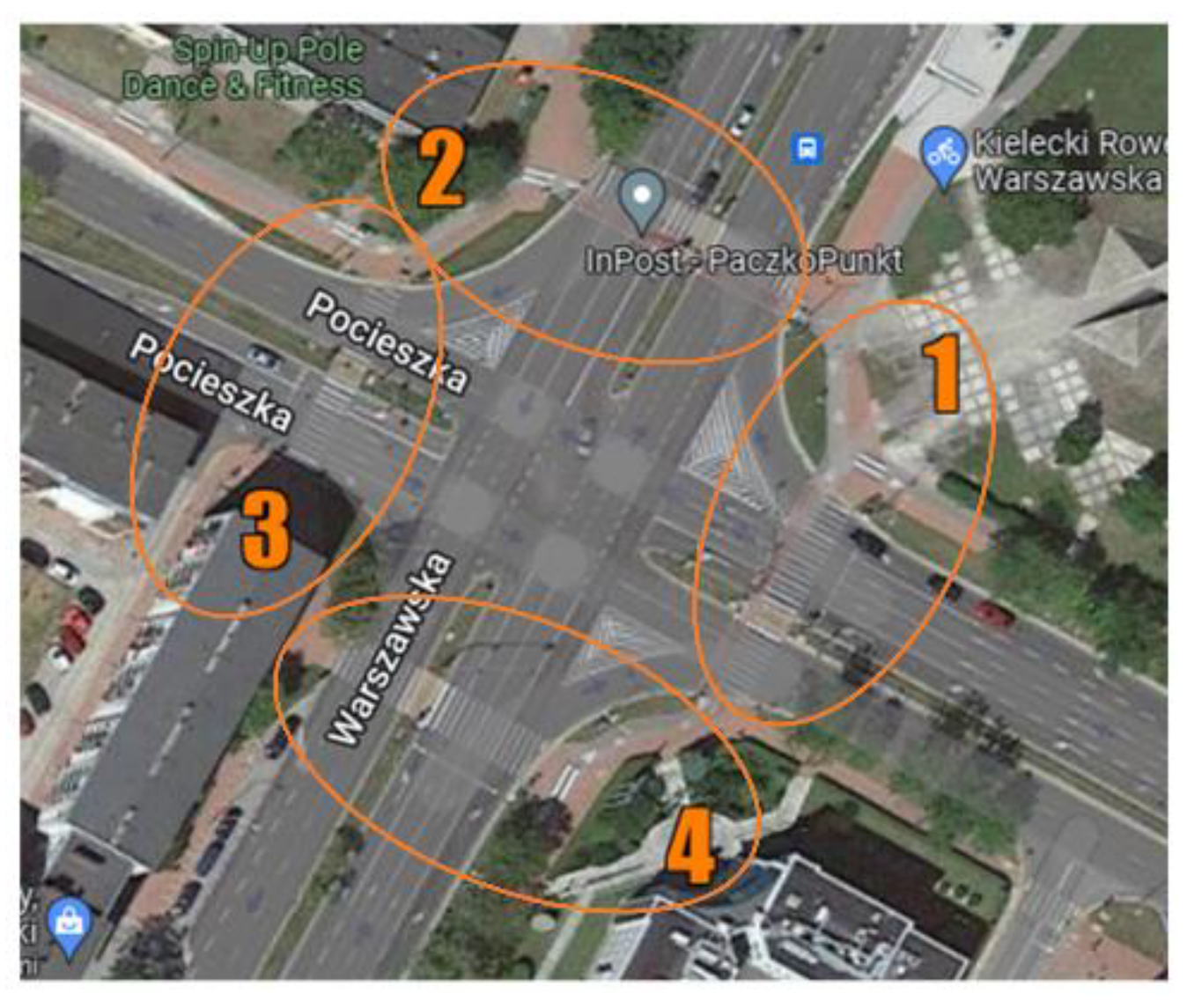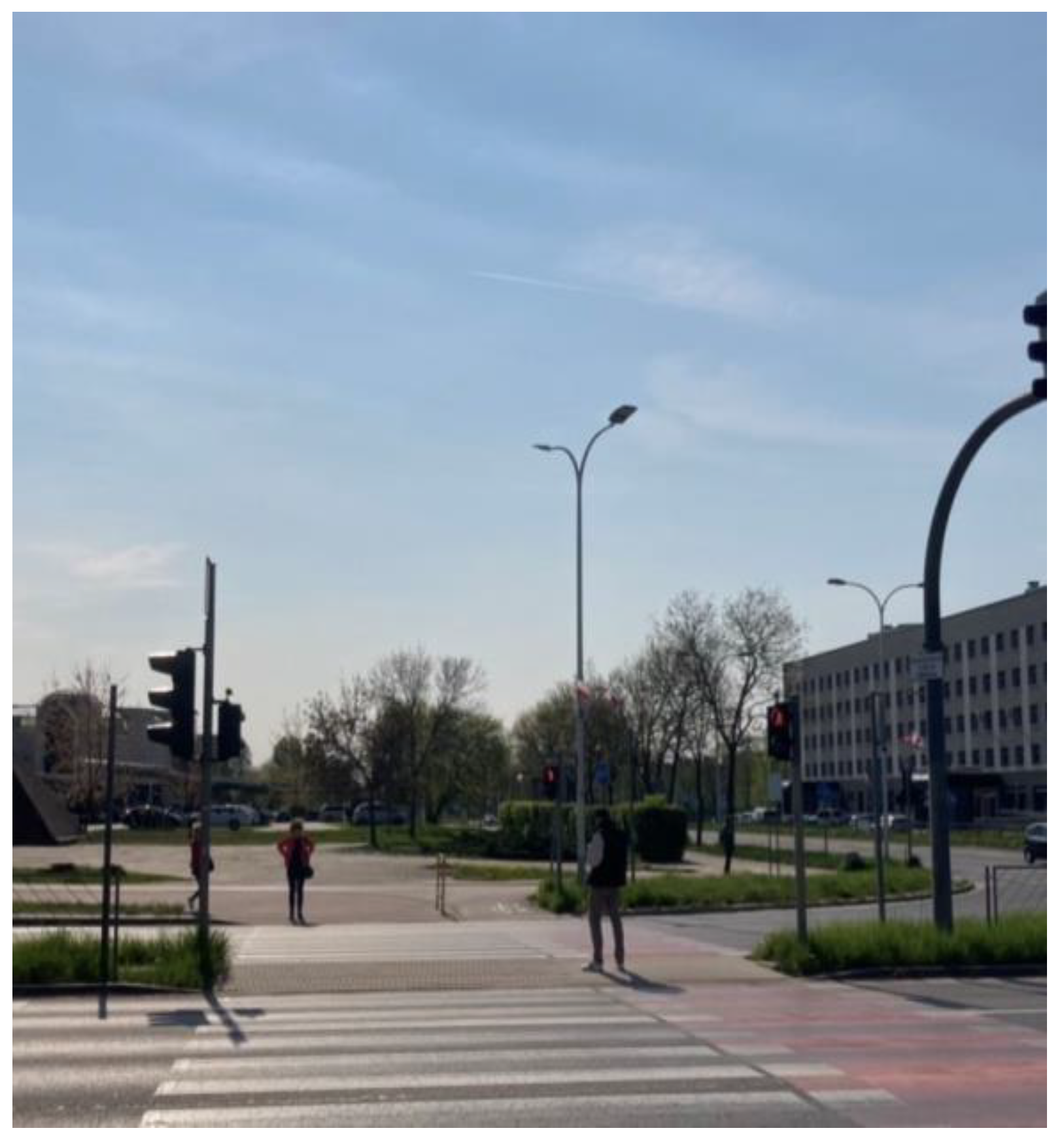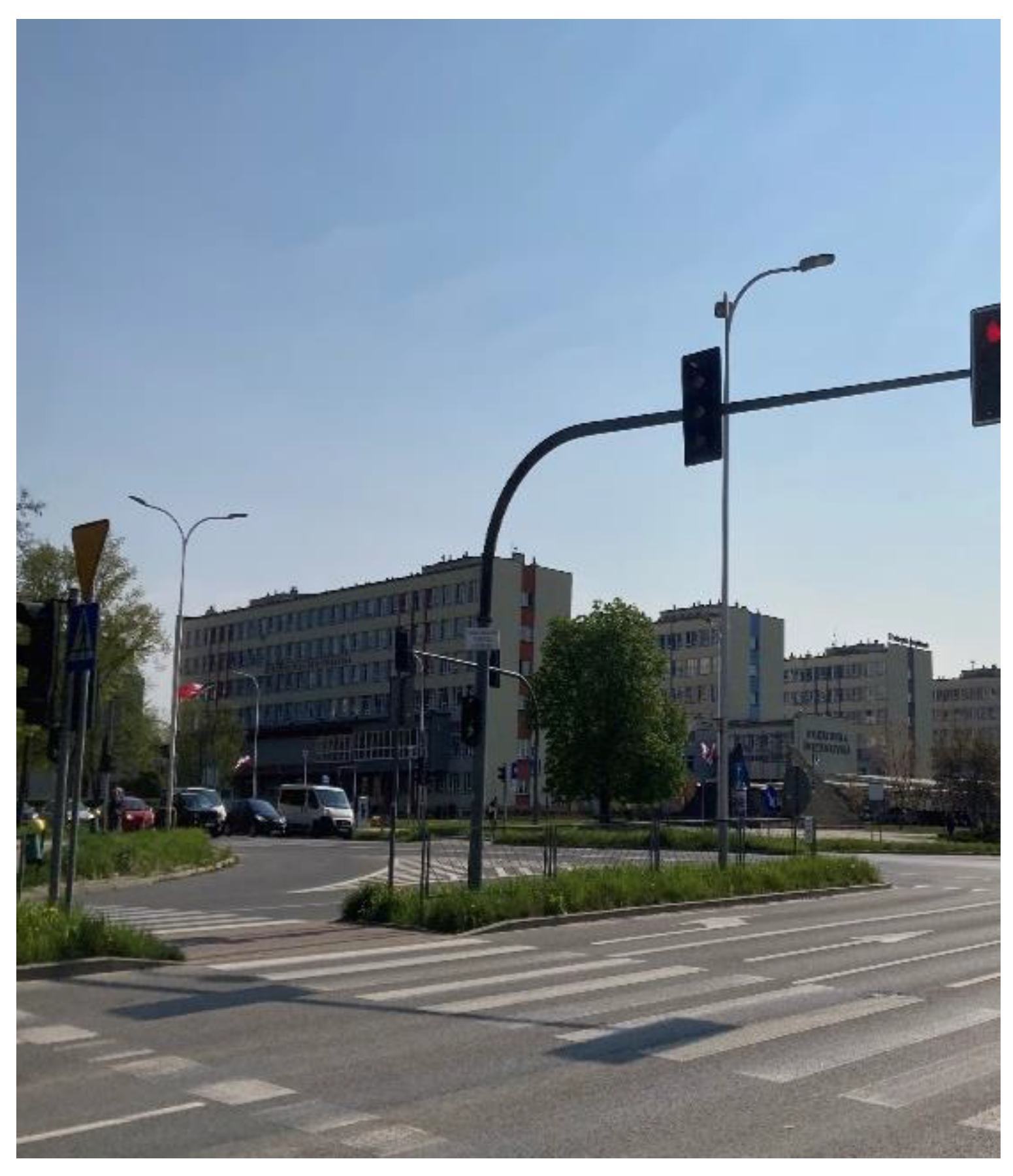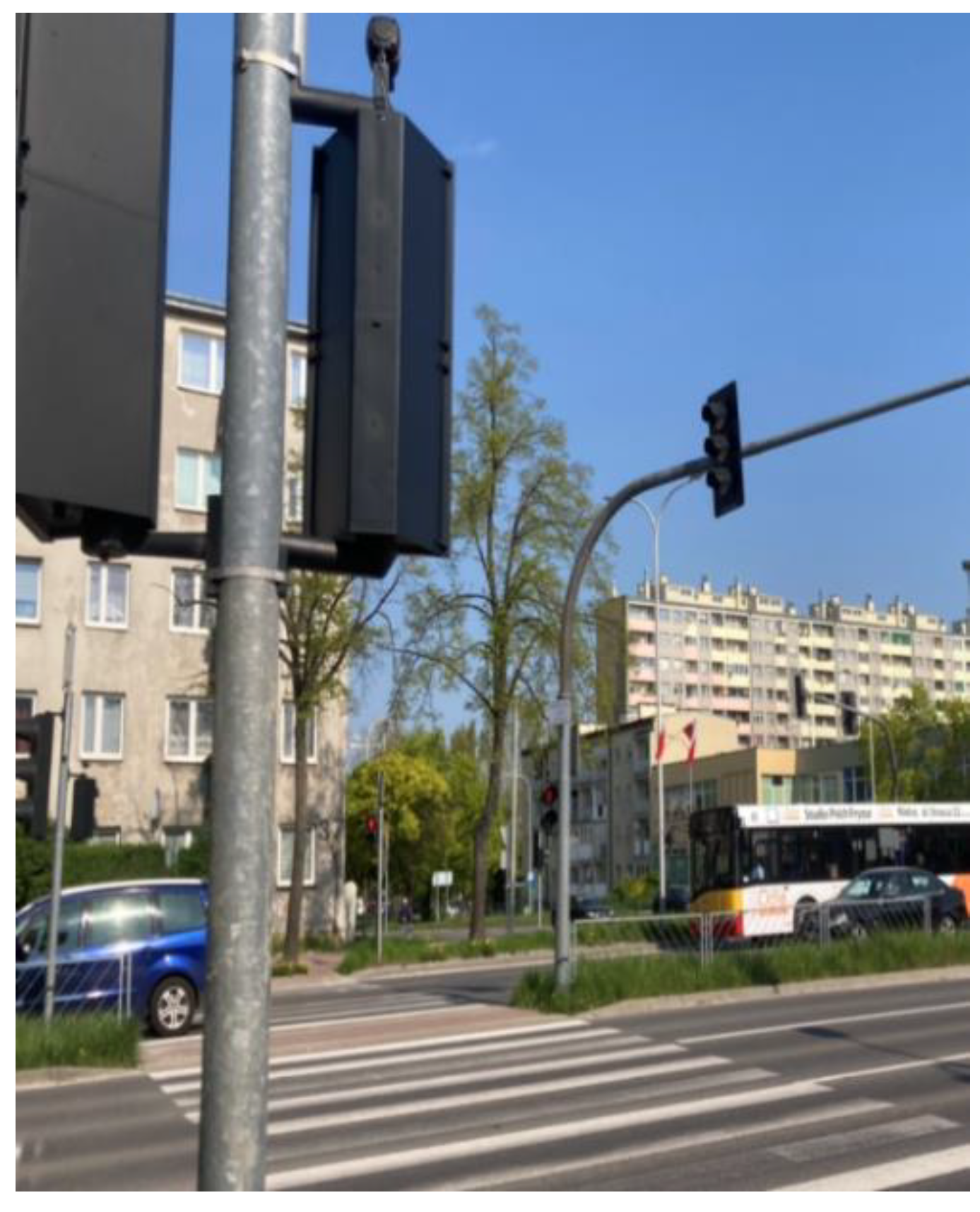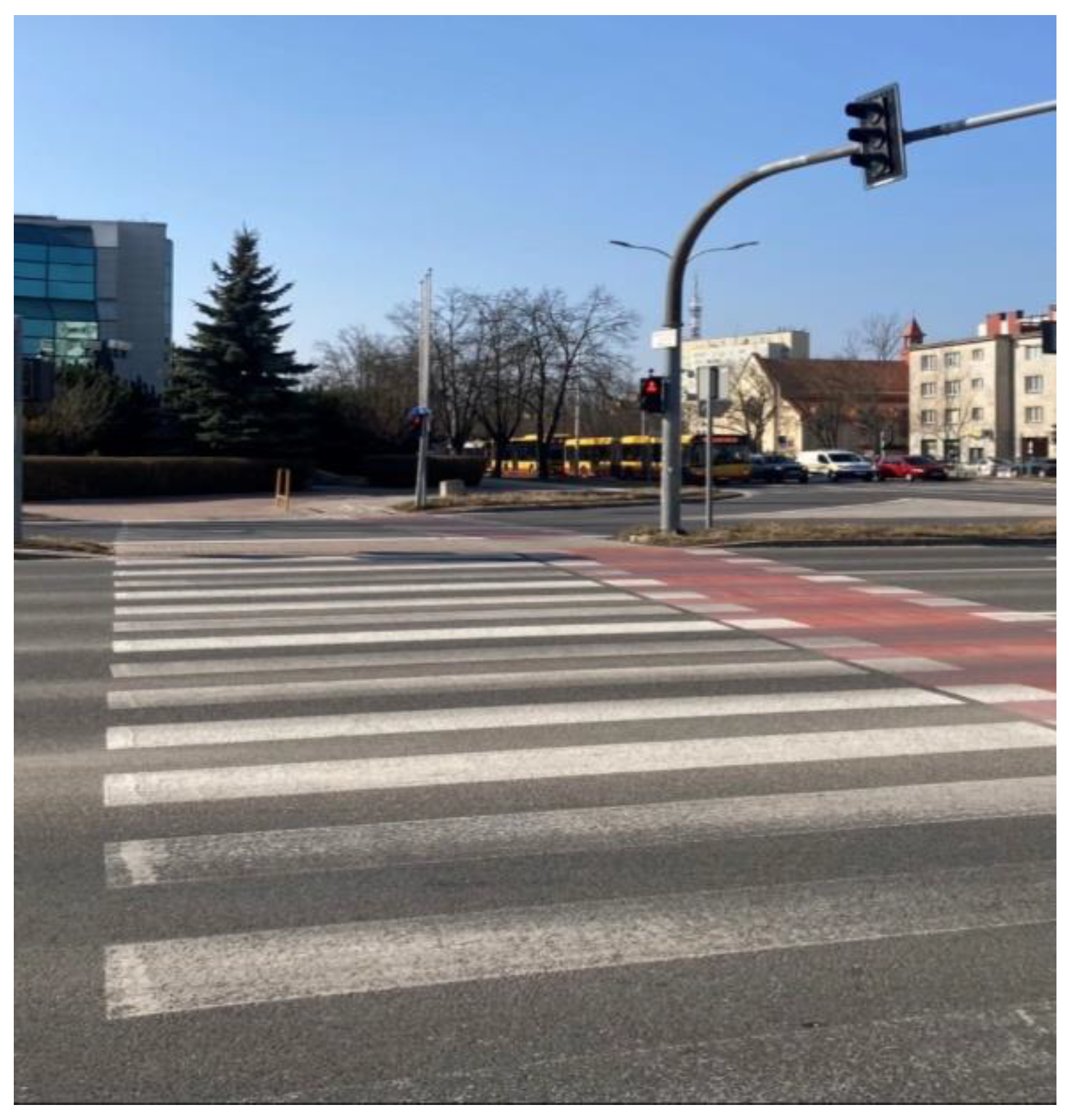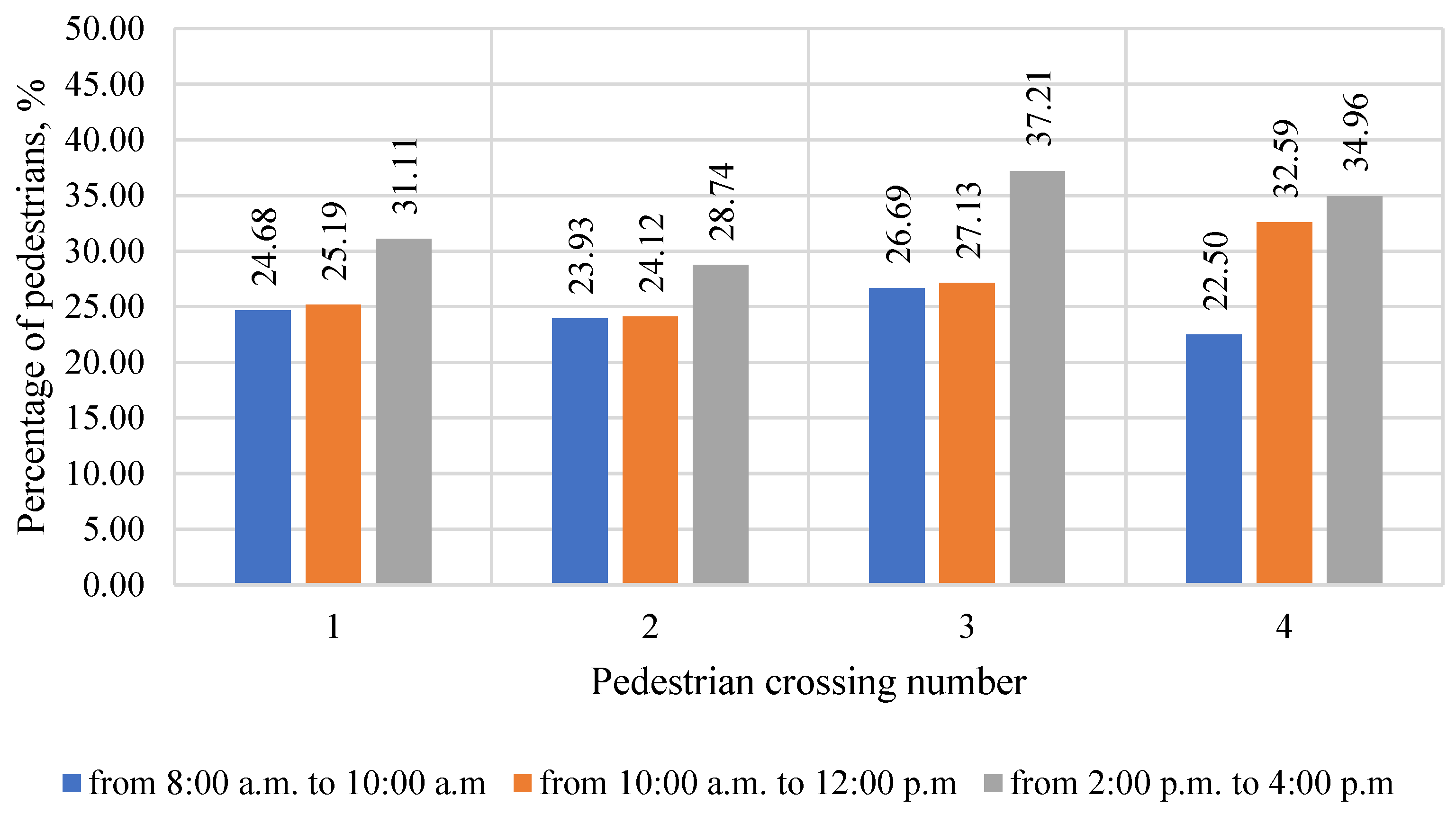1. Introduction
Mobile phones accompany people in everyday life. The use of smartphones is becoming more and more popular all over the world. This is because the available applications in a smartphone facilitate and accelerate the performance of ordinary tasks [
1,
2,
3]. For example, using a mobile phone, people can order food, shop, pay bills or see a doctor with just a few clicks. All the functions of smartphones mean that people more and more often benefit from the digital world, regardless of the threats that mobile phones can pose [
4,
5]. In terms of road safety, mobile phones can impair correct visual perception and thus the assessment of safely entering and overcoming a road or track. Over the past 10 years, many scientific studies have confirmed that the illegal use of smartphone-type mobile phones while driving a vehicle deteriorates driving performance [
6,
7,
8] and at the same time contributes to an increased risk of incurring a road collision [
9,
10,
11]. Calling and texting are major driver distractions. Distracting attention by calling and writing text messages or messages on social networks significantly worsens the driver’s performance while driving and at the same time greatly increases the risk of a road collision [
12,
13,
14,
15,
16,
17].
Using a mobile phone while driving is prohibited in most European Union countries because texting requires the driver to direct their eyes from the road to the mobile phone screen while taking their hands off the steering wheel to write or read the message. Therefore, sending text messages while driving is extremely dangerous [
18,
19,
20]. Vehicle manufacturers, taking into account the safety of travelers and other road users, equip vehicles with loudspeaker systems and enable the connection of a mobile phone to the vehicle’s system, e.g., using Android Auto [
21,
22,
23]. In addition, in such vehicles, messages are often displayed to the driver, messages that for safety reasons are not possible to use the Android Auto function. In the case of pedestrians, an effective method limiting the use of a mobile phone while crossing a pedestrian crossing is prevention and recognizing the dangerous effects of such behaviors [
24,
25,
26,
27].
2. Methodology
The article uses surveys and observational studies. The survey was carried out using a Google survey questionnaire. Surveys are one of the most frequently used techniques for research and data analysis. In order to find out the respondents’ opinions regarding the use of a mobile phone while moving on the street and when crossing a pedestrian crossing, surveys turned out to be the best solution. Prior to participating in the study, the respondents agreed to participate in the survey. They were then able to answer the 29 questions included in the survey questionnaire.
The first part of the questions refers to sociodemographic characteristics. Respondents were asked to provide information on gender, age, education and place of residence. In the second part of the questionnaire, the respondents provided information on the use of mobile phones in various situations, e.g., when crossing a pedestrian crossing. The Google survey questionnaire allowed all interested persons to participate in the study. If the respondent used a mobile phone while crossing a pedestrian crossing, they were asked for additional information, e.g., what activities they performed on the mobile phone. And if the respondent did not use a mobile phone, they were not asked for additional information.
Observation was used in the data collection process. Observation is one of the foundations of scientific research. Often it is also difficult to investigate something without personal participation in the analyzed project. In order to check the reliability of statistical data from surveys, observational studies were carried out to observe pedestrian behavior at four pedestrian crossings. In the course of research and the collection of data or descriptive statements, the observer uses and records everything in an observation sheet or journal. Therefore, during the observation, the observers meticulously recorded how many people crossed the pedestrian crossing during one light cycle, how many people used the phone while waiting at the pedestrian crossing and how many people crossing the pedestrian crossing used a mobile phone. At each pedestrian crossing, observations were made by six people. Two people standing in front of a pedestrian crossing recorded how many people use a mobile phone. Two people behind a pedestrian crossing recorded how many people used a mobile phone. The other two people recorded how many people passed through the indicated pedestrian crossing, divided according to the traffic light cycle. In addition, people recorded during the observation how many pedestrians entered the pedestrian crossing with green, red, and green-flashing lights with open traffic.
The observational studies carried out were intended to show the number of people using mobile phones at the pedestrian crossing. The people making the observations did not distinguish between people in terms of activities performed with the mobile phone. Whether a person entering a pedestrian crossing was talking on the phone, looking at the phone or listening to music through headphones holding the phone in hand, they were treated as a person using a mobile phone.
3. Use of Smartphones
There are approximately 6.57 billion smartphones worldwide. Over the past few decades, technology has become the basis for progress, uniting the world socially and economically [
25,
26,
28,
29]. This phenomenon is particularly evident in developing countries and emerging markets, where the use of smartphone technology is a manifestation of a competitive advantage [
30,
31]. The use of smartphones around the world has increased in recent years. In developed countries, 84% of the population has access to smartphones. It is estimated that over 10 billion devices connected to mobile devices are in use worldwide [
31,
32]. The UK had one of the highest smartphone penetration rates in the world in the first quarter of 2022. In Great Britain, 82.2% of the population used a smartphone in the first quarter of 2022. In Sweden and Germany, smartphone penetration was 78% in the first quarter of 2022 [
30,
31,
32,
33]. In Poland, it was 64%, which proves that more than half of the population uses a smartphone [
34].
Figure 1 shows the smartphone penetration characteristics in selected countries.
The number of smartphone users has been growing steadily around the world. In 2019, the number of smartphone users in the world exceeded the level of three billion. This growth trend is predicted to continue over the next few years, adding several hundred million smartphone users annually to the global user base. Annually, sales of new smartphones stand at around 1.5 billion units, so an increase in the number of smartphone users is inevitable [
35,
36]. In the United States, about 40% of parents equip their children with their first mobile phone before they are 10 years old. In some cases, such a device is already provided to three-year-olds [
37,
38].
With each passing year, smartphones are becoming more efficient and versatile. Undoubtedly, this leads to increased adoption among users and an increase in the daily time spent on smartphone screens [
37,
38,
39]. On average, people spend as much as 3 h and 15 min a day on their phones. Perhaps surprisingly, on average, your smartphone is used more often on weekdays than on weekends. People check their phones an average of 58 times a day [
38,
39,
40]. And almost 52% of mobile phone checks (30 a day) take place during working hours. Smartphone users most often use the device for the following [
37,
39]:
browsing websites—82.1%;
using instant messaging—79.9%;
using social networks—74.1%;
receiving/sending email—67.5%;
using mobile applications—66.6%;
online shopping—41.6%;
listening to music/radio—40.6%;
taking care of official matters—30.1%;
watching tv/movies, tv on demand—22.4%;
sharing their own content—21.3%;
playing games—19.5%;
internet sales—15.4%.
Every year, there are more and more collisions caused by the use of mobile phones. Using a mobile phone is dangerous for both pedestrians and drivers. Pedestrians, fascinated by what they see on phone screens, do not pay attention to what is happening on the street. Pedestrians can often be observed walking in an unknown direction with their heads pointed at the mobile phone screen [
37,
38,
39]. It is especially dangerous when they cross the street in this way by entering pedestrian crossings. A pedestrian looking at the screen of a mobile phone registers the movement of vehicles on the ride only from the corner of their eye. Police collision statistics show that such behavior leads to an increasing number of pedestrians’ dying at road crossings [
41,
42,
43,
44]. Pedestrians dominate the structure of those killed as a result of the road accident. In 2019, there were almost 7000 pedestrian collisions, in which 780 people were killed. For the purpose of limiting such collisions a special traffic light appears at some crossings, illuminating the pavement just in front of the road in red or green. In addition, more and more information campaigns are organized to make people aware of the growing problem related to the irresponsible use of smartphones. Despite the tightening of the Polish road traffic law, it is still possible to meet people crossing a pedestrian crossing with a mobile phone in their hands [
45,
46,
47].
4. Use of Mobile Phones: Pedestrians Walking Down the Street or On the Sidewalk
Surveys carried out at the Department of Motor Vehicles and Transport at the Kielce University of Technology in the period from 15 October 2021 to 1 September 2022 confirmed the frequent use of mobile phones by pedestrians walking down the street and crossing a pedestrian crossing. In the survey, 451 women and 369 men participated. The largest group, of 342 people, were respondents aged 18 to 25. Moreover, 231 people aged 26 to 35, 158 people aged 36 to 45, 57 people aged 46 to 60 and 32 people aged over 60 participated in the study.
Respondents were asked about using a mobile phone while walking on the sidewalk or roadside. This question uses a five-point Likert scale. The Likert scale is the most popular estimation and dependency scale for measuring attitudes of human behavior. It is widely used for questionnaires, surveys and forms. Respondents had the following answers to choose from: yes, probably yes, probably not, not and it’s hard to say. The respondents who chose the answer “it’s hard to say” did not give a clear decision. In addition, as many as 37% of respondents used a mobile phone while walking on the street or sidewalk, as opposed to only 5% of respondents who did not use a mobile phone while walking on the street or sidewalk. Moreover, as many as 46% of the respondents used a mobile phone while walking on the street or on the sidewalk. The characteristics of the respondents in terms of using a mobile phone while moving along the street or sidewalk are shown in
Figure 2.
Another question was how often the respondents use a mobile phone while walking along the sidewalk or roadside. This question also uses a five-point Likert scale. Respondents had the following answers to choose from: Always, sometimes, occasionally, from time to time and never. The characteristics of the respondents in terms of the frequency of using a mobile phone while walking on the street or sidewalk are presented in
Figure 3. As many as 26% of respondents always use a mobile phone while walking on a street or sidewalk. Of the respondents, 43% sometimes use a mobile phone while walking on the street or on the sidewalk; 16% of the respondents occasionally do so; 12% of respondents from time to time use the mobile phone while walking down the street or sidewalk; and only 3% of the respondents do not use a mobile phone while walking on the street or on the sidewalk.
In the next question, the respondents were asked to specify what activities they perform using a mobile phone while walking on the sidewalk, roadside or street. In this question, respondents had seven possible answers to tick. Respondents could select more than one answer in the question. Respondents could select such answers as: I am on the phone; I listen to my favorite music; I watch movies/series, music videos; I’m listening to the radio; I write SMSs and messages; I browse social networks; or I’m not using the phone. The characteristics of the respondents in terms of the use of a mobile phone while navigating the street or sidewalk are presented in
Figure 4. The current smartphone-type mobile phones have many capabilities. The respondents most often use a mobile phone to make calls and write SMSs and messages on social networks. When moving along the street or sidewalk, as many as 84% of respondents talk on the phone, 79% of respondents write text messages or messages on social networks, 67% browse social networks, 44% listen to music and 33% watch movies on the internet.
5. Use of Mobile Phones When Crossing a Pedestrian Crossing
According to Polish road traffic law, the use of a mobile phone while crossing pedestrian crossings is subject to a fine of PLN 300. The respondents were then asked whether they used a mobile phone on a pedestrian crossing. This question also uses a five-point Likert scale. Respondents had the following answers to choose from: yes, probably yes, probably not, not and it’s hard to say. The characteristics of the respondents in terms of using a mobile phone when crossing a pedestrian crossing are presented in
Figure 5. It should be noted that 21% of respondents definitely do not use a mobile phone when crossing a pedestrian crossing, whereas as many as 30% of respondents do not use a mobile phone. Despite the possibility of receiving a ticket, as many as 25% of respondents would still use the mobile phone when crossing the pedestrian crossing, and 21% of the respondents declare that they would still use the mobile phone when crossing the pedestrian crossing.
Another question concerned how often respondents use a mobile phone when crossing a pedestrian crossing. This question also uses a five-point Likert scale. Respondents had the following answers to choose from: always, sometimes, occasionally, from time to time and never. The characteristics of the respondents in terms of the frequency of using a mobile phone while crossing a pedestrian crossing are presented in
Figure 6. When crossing a pedestrian crossing, 16% of the respondents always use a mobile phone; 21% of respondents sometimes use a mobile phone when crossing a pedestrian crossing; 23% of respondents occasionally use a mobile phone when crossing a pedestrian crossing; 16% of respondents from time to time use a mobile phone when crossing a pedestrian crossing; and only 24% of respondents never use a mobile phone when crossing a pedestrian crossing.
In the next question, respondents were asked to specify what activities they perform using a mobile phone while crossing a pedestrian crossing. In this question, respondents had seven possible answers to tick. Respondents could select more than one answer in the question. Respondents could select such answers as: I am on the phone; I listen to my favorite music; I watch movies/series, music videos; I’m listening to the radio; I write SMSs and messages; I browse social networks; or I’m not using the phone. The characteristics of the respondents in terms of the most frequently performed activity on a mobile phone while crossing a pedestrian crossing are presented in
Figure 7. Among the respondents who use mobile phones while crossing a pedestrian crossing, 34% most often listen to music, 30% talk on the phone, 16% write SMSs or messages on social networks, 14% watch movies and 6% view social networks.
6. Observation of People Using Mobile Phones While Crossing a Pedestrian Crossing
In order to verify the credibility of the survey, observational studies were carried out at the intersection of Warszawska Street and Pocieszka Street in Kielce at the Department of Motor Vehicles and Transport at the Kielce University of Technology.
The observations were conducted from 8:00 a.m. to noon and from 2:00 p.m. to 4:00 p.m. Observational studies were aimed at identifying people using a mobile phone while crossing a pedestrian crossing.
Figure 8 shows a satellite photo of the analyzed intersection with the markings of the observation sites. The measurement places are shown in
Figure 9,
Figure 10,
Figure 11 and
Figure 12. The observation was deliberately carried out at one intersection with traffic lights, because there are four almost-identical pedestrian crossings that contain no “green wave” and for which the duration of the green signal is from 20 to 24 s.
The results of the observations are presented in
Table 1. The observation was carried out on all pedestrian crossings and included over 2223 people. Among these people, as many as 631 used a mobile phone. Therefore, as many as 28.4% of people crossing the pedestrian crossing used a mobile phone. From 8.00 a.m. to 10.00 a.m., 632 people passed through pedestrian crossings, including as many as 156 (24%) with a mobile phone. The largest number of people with a cork mobile phone passed through the second pedestrian crossing (51 people), and the least through the fourth pedestrian crossing (23 people). From 10:00 a.m. to noon, 657 people passed through the crossings, including as many as 175 (26%) with a mobile phone. The largest number of people with a cork mobile phone passed through the second pedestrian crossing (55 people), and the least through the first pedestrian crossing (33 people). From 2 p.m. to 4 p.m., 934 people passed through pedestrian crossings, including as many as 301 (32%) with a mobile phone. The largest number of people with a cork mobile phone passed through the second pedestrian crossing (96 people), and the least through the fourth pedestrian crossing (43 people).
The percentage characteristics of people walking with a mobile phone through the pedestrian crossing according to the hours of observation are presented in
Figure 13. The percentage of people using mobile phones at the pedestrian crossing range from 22.50% to 37.21%, depending on the hours of observation and pedestrian crossings.
7. Conclusions
Pedestrians crossing the road in the designated place must exercise particular caution. When crossing the road, they are obliged to use marked pedestrian crossings. In addition, while walking, pedestrians should observe their surroundings and react to potential threats and situations including vehicle drivers, because a person crossing the road while busy on a phone call or focused on the phone screen is not able to react in time to a potential threat. Undoubtedly, in the event of a pedestrian incident with a vehicle, the pedestrian is protected by nothing in that they do not use seat belts or other vehicle systems that protect drivers. According to Polish road traffic law, pedestrians have priority crossing the road over oncoming traffic. However, the principle of limited trust should always be kept in mind.
Despite changes in Polish road traffic law on the use of cork mobile phones by pedestrians passing across the road, you can still often find pedestrians with a mobile phone in their hands. Observations of an intersection with four pedestrian crossings showed that approximately 22% to 37% of pedestrians use mobile phones when crossing the pedestrian crossing. Perhaps this was because at such an intersection, traffic lights coordinate the movement of pedestrians and vehicles, which contributed to the reduced caution of pedestrians. During the observations, at all pedestrian crossings, as many as 35 people entered pedestrian crossings with a flashing green light and left them with a red signal when vehicles were waiting for a green signal. During the observation, there were no cases of a pedestrian entering a pedestrian crossing with open traffic or a red signal with closed traffic.
Author Contributions
Conceptualization, D.F. and M.J.; methodology, D.F.; software, D.F.; validation, D.F., M.J. and M.P.; formal analysis, D.F.; investigation, D.F.; resources, D.F.; data curation, D.F.; writing—original draft preparation, D.F. and M.P.; writing—review and editing, D.F. and M.J.; visualization, D.F. and Z.Z.; supervision, M.J. and M.P.; project administration, D.F. and M.J.; funding acquisition, M.J. and M.P. All authors have read and agreed to the published version of the manuscript.
Funding
This research received no external funding.
Institutional Review Board Statement
The study was conducted in accordance with the Declaration of Helsinki, and approved by the Institutional Ethics Committee of Kielce University of Tehnologi NAME OF INSTITUTE (003 of the day 03 November 2022).
Informed Consent Statement
Informed consent was obtained from all subjects involved in the study.
Data Availability Statement
Data are available from the corresponding author.
Conflicts of Interest
The authors declare no conflict of interest.
References
- Kent, S.; Masterson, C.; Ali, R.; Parsons, C.E.; Bewick, B.M. Digital Intervention for Problematic Smartphone Use. Int. J. Environ. Res. Public Health 2021, 18, 13165. [Google Scholar] [CrossRef] [PubMed]
- The Lancet Child Adolescent Health. Growing up in a digital world: Benefits and risks. Lancet Child. Adolesc. Health 2018, 2, 79. [Google Scholar] [CrossRef] [PubMed]
- Violano, P.; Roney, L.; Bechtel, K. The incidence of pedestrian distraction at urban intersections after implementation of a Streets Smarts campaign. Inj. Epidemiol. 2015, 2, 18. [Google Scholar] [CrossRef] [PubMed]
- Casado-Sanz, N.; Guirao, B.; Lara Galera, A.; Attard, M. Investigating the risk factors associated with the severity of the pedestrians injured on Spanish crosstown roads. Sustainability 2019, 11, 5194. [Google Scholar] [CrossRef]
- Eboli, L.; Forciniti, C. The severity of traffic crashes in Italy: An explorative analysis among different driving circumstances. Sustainability 2020, 12, 856. [Google Scholar] [CrossRef]
- Bendak, S. Objective assessment of the effects of texting while driving: A simulator study. Int. J. Inj. Control. Saf. Promot. 2015, 22, 387–392. [Google Scholar] [CrossRef]
- Niu, J.; Wang, X.; Liu, X.; Wang, D.; Qin, H.; Zhang, Y. Effects of mobile phone use on driving performance in a multiresource workload scenario. Traffic Inj. Prev. 2019, 20, 37–44. [Google Scholar] [CrossRef]
- Rumschlag, G.; Palumbo, T.; Martin, A.; Head, D.; George, R.; Commissaris, R.L. The effects of texting on driving performance in a driving simulator: The influence of driver age. Accid. Anal. Prev. 2015, 74, 145–149. [Google Scholar] [CrossRef]
- Choudhary, P.; Velaga, N.R. Effects of texting on accident risk during a sudden hazardous event: Analysis of predetection and postdetection phases. Traffic Inj. Prev. 2018, 19, 806–811. [Google Scholar] [CrossRef]
- Gauld, C.S.; Lewis, I.M.; White, K.M.; Watson, B. Young drivers’ engagement with social interactive technology on their smartphone: Critical beliefs to target in public education messages. Accid. Anal. Prev. 2016, 96, 208–218. [Google Scholar] [CrossRef]
- Truong, L.T.; Nguyen, H.T.; De Gruyter, C. Mobile phone use while riding a motorcycle and crashes among university students. Traffic Inj. Prev. 2019, 20, 204–210. [Google Scholar] [CrossRef] [PubMed]
- Eboli, L.; Mazzulla, G.; Pungillo, G. The influence of physical and emotional factors on driving style of car drivers: A survey design. Travel Behav. Soc. 2017, 7, 43–51. [Google Scholar] [CrossRef]
- Beede, K.E.; Kass, S.J. Engrossed in conversation: The impact of cell phones on simulated driving performance. Accid. Anal. Prev. 2006, 38, 415–421. [Google Scholar] [CrossRef] [PubMed]
- Consiglio, W.; Driscoll, P.; Witte, M.; Berg, W.P. Effect of cellular tele-phone conversations and other potential interference on reaction time in a braking response. Accid. Anal. Prev. 2003, 35, 495–500. [Google Scholar] [CrossRef] [PubMed]
- Hancock, P.; Lesch, M.; Simmons, L. The distraction effects of phone use during a crucial driving maneuver. Accid. Anal. Prev. 2003, 35, 501–514. [Google Scholar] [CrossRef] [PubMed]
- Horrey, W.J.; Wickens, C.D. Examining the impact of cell phone conversations on driving using meta-analytic techniques. Hum. Factors 2006, 48, 196–205. [Google Scholar] [CrossRef] [PubMed]
- Hosking, S.G.; Young, K.L.; Regan, M.A. The effects of text messaging on young drivers. Hum. Factors 2009, 51, 582–592. [Google Scholar] [CrossRef] [PubMed]
- Just, M.A.; Keller, T.A.; Cynkar, J. A decrease in brain activation associated with driving when listening to someone speak. Brain Res. 2008, 1205, 70–80. [Google Scholar] [CrossRef] [PubMed]
- Strayer, D.L.; Johnston, W.A. Driven to distraction: Dual-task studies of simulated driving and conversing on a cellular telephone. Psychol. Sci. 2001, 12, 462–466. [Google Scholar] [CrossRef]
- Nemme, H.E.; White, K.M. Texting while driving: Psychosocial influences on young people’s texting intentions and behaviour. Accid. Anal. Prev. 2010, 42, 1257–1265. [Google Scholar] [CrossRef]
- Android Auto FAQ: Everything You Need to Know. Available online: https://www.tomsguide.com/reference/android-auto-faq (accessed on 1 October 2022).
- What Is Android Auto and Its Top 5 Functionalities. Available online: https://thedroidguy.com/android-auto-top-5-functionalities-1065927 (accessed on 1 October 2022).
- What Is Android Auto and What Can It Do? Available online: https://www.slashgear.com/785203/what-is-android-auto-and-what-can-it-do/?utm_campaign=clip (accessed on 1 October 2022).
- Gruden, C.; Ištoka Otković, I.; Šraml, M. Safety Analysis of Young Pedestrian Behavior at Signalized Intersections: An Eye-Tracking Study. Sustainability 2021, 13, 4419. [Google Scholar] [CrossRef]
- Alejalil, N.; Davoodi, S.R. Mobile phone use and its effects on pedestrian distraction. Int. J. High Risk Behav. Addict. 2016, 6, e35431. [Google Scholar] [CrossRef]
- Hatfield, J.; Murphy, S. The effects of Mobile phone use on pedestrian crossing behavior at signalized and unsignalized intersections. Accid. Anal. Prev. 2007, 39, 197–205. [Google Scholar] [CrossRef]
- Lipovac, K.; Đerić, M.; Tešić, M.; Andrić, Z.; Marić, B. Mobile phone use while driving-literary review. Transp. Res. Part F Traffic Psychol. Behav. 2017, 47, 132–142. [Google Scholar] [CrossRef]
- De Waard, D.; Schepers, P.; Ormel, W.; Brookhuis, K. Mobile phone use while cycling: Incidence and effects on behavior and safety. Ergonomics 2010, 53, 30–42. [Google Scholar] [CrossRef] [PubMed]
- Number of Smartphone Users by Leading Countries in 2021 (in Millions). Available online: https://www.statista.com/statistics/748053/worldwide-top-countries-smartphone-users/ (accessed on 1 October 2022).
- Trust, Security and Privacy-Smartphones (2020 Onwards). Available online: https://ec.europa.eu/eurostat/databrowser/view/ISOC_CISCI_SP20__custom_914759/bookmark/bar?lang=en&bookmarkId=2e74a4ad-6ba9-4a27-8fe9-6dccddf75274 (accessed on 1 October 2022).
- Smartphone Penetration Worldwide as Share of Global Population 2016–2020. Available online: https://www.statista.com/statistics/203734/global-smartphone-penetration-per-capita-since-2005/ (accessed on 1 October 2022).
- Kraje Wg Penetracji Smartfona. Available online: https://pl.history-hub.com/kraje-wg-penetracji-smartfona (accessed on 1 October 2022).
- Top Countries by Smartphone Users. Available online: https://newzoo.com/insights/rankings/top-countries-by-smartphone-penetration-and-users (accessed on 1 October 2022).
- UKE: 92,9% Polaków Korzystało Z Telefonu Komórkowego, 70,5% Z Internetu W 2019r. Available online: https://www.money.pl/gielda/uke-92-9-polakow-korzystalo-z-telefonu-komorkowego-70-5-z-internetu-w-2019r-6479674512459393a.html (accessed on 1 October 2022).
- How Mobile Users Spend Their Time on Their Smartphones in 2022. Available online: https://www.insiderintelligence.com/insights/mobile-users-smartphone-usage/ (accessed on 1 October 2022).
- What are the Most Popular Reasons Why People Use Their Smartphones Every Day? Available online: https://www.gadget-cover.com/blog/what-are-the-most-popular-reasons-why-people-use-their-smartphones-every-day (accessed on 1 October 2022).
- Use of Smartphones and Social Media Is Common across Most Emerging Economies. Available online: https://www.pewresearch.org/internet/2019/03/07/use-of-smartphones-and-social-media-is-common-across-most-emerging-economies/ (accessed on 1 October 2022).
- Who You Gonna Call? Check Out the Latest Mobile Phone Usage Statistics. Available online: https://dataprot.net/statistics/mobile-phone-usage-statistics/ (accessed on 1 October 2022).
- Screen Time Statistics: Your Smartphone Is Hurting You. Available online: https://elitecontentmarketer.com/screen-time-statistics/ (accessed on 1 October 2022).
- How Much Time on Average Do You Spend on Your Phone on a Daily Basis? Available online: https://www.statista.com/statistics/1224510/time-spent-per-day-on-smartphone-us/ (accessed on 1 October 2022).
- Wypadki Drogowe-Raporty Roczne. Available online: https://statystyka.policja.pl/st/ruch-drogowy/76562,wypadki-drogowe-raporty-roczne.html (accessed on 1 October 2022).
- Zuska, A.; Frej, D.; Jackowski, J.; Żmuda, M. Research and Analysis of the Propagation of Vertical Vibrations in the Arrangement of a Vehicle Seat—A Child’s Seat. Sensors 2021, 21, 8230. [Google Scholar] [CrossRef] [PubMed]
- Jaśkiewicz, M.; Frej, D.; Matej, J.; Chaba, R. Analysis of the Head of a Simulation Crash Test Dummy with Speed Motion. Energies 2021, 14, 1476. [Google Scholar] [CrossRef]
- Nowe Przepisy Niewiele Zmieniły. Policja Podsumowała Statystyki Wypadków W 2021 r. Available online: https://autokult.pl/44208,nowe-przepisy-niewiele-zmienily-policja-podsumowala-wypadki-w-2021-r (accessed on 1 October 2022).
- Moravčík, E.; Jaśkiewicz, M. Boosting car safety in the EU. In Proceedings of the 2018 XI International Science-Technical Conference Automotive Safety, Žastá, Slovakia, 18–20 April 2018; pp. 1–5. [Google Scholar] [CrossRef]
- Tomczuk, P. Wymagania formalne dotyczące oświetlenia przejść dla pieszych. Autobusy Tech. Eksploat. Syst. Transportowe. 2011, 12, 392–402. [Google Scholar]
- Frej, D.P.; Ludwinek, K. Analysis of road accidents in 2002–2019 on the example of Poland. Arch. Automot. Eng.—Arch. Motoryz. 2020, 89, 5–18. [Google Scholar] [CrossRef]
| Publisher’s Note: MDPI stays neutral with regard to jurisdictional claims in published maps and institutional affiliations. |
© 2022 by the authors. Licensee MDPI, Basel, Switzerland. This article is an open access article distributed under the terms and conditions of the Creative Commons Attribution (CC BY) license (https://creativecommons.org/licenses/by/4.0/).
